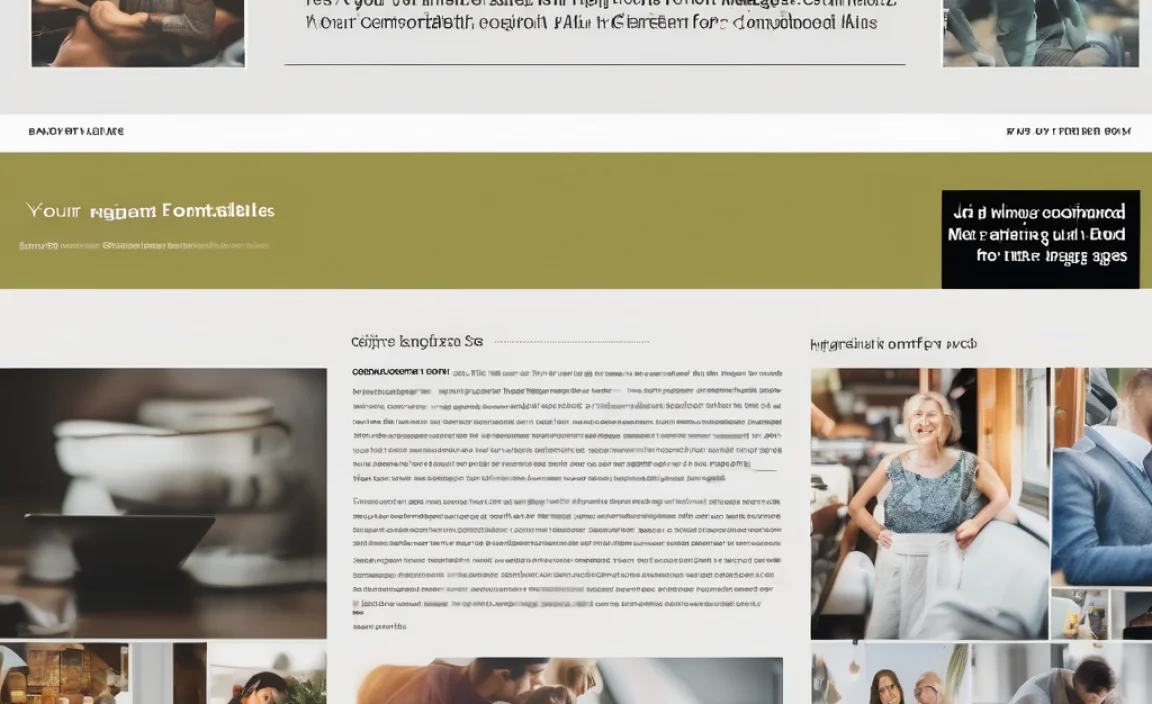Old London Font is a versatile typeface that adds a touch of vintage charm and classic elegance to designs. It’s an essential tool for creating sophisticated branding, captivating web content, and eye-catching print materials, offering excellent readability and a distinct personality for beginner and experienced designers alike.
Ever scrolled through a website or admired a beautiful brochure and thought, “What font is that?” Typography can feel like a secret code, especially when you’re just starting out. Many beginners find it tricky to choose fonts that look professional without being overly complex. Sometimes, the perfect font seems just out of reach, leaving your designs feeling a bit… ordinary. But what if I told you there’s a font that can instantly bring a touch of timeless sophistication to your projects? A font that’s both elegant and incredibly user-friendly? Let’s explore how the Old London font can become your go-to for stunning designs, making you feel more confident with every creative choice.
Unveiling the Old London Font: A Touch of Timeless Class
The Old London font evokes a sense of history, tradition, and refined elegance. It’s a typeface that speaks of craftsmanship and enduring style, reminiscent of classic print and formal signage from eras past. Think of the ornate lettering on antique books, the graceful curves of vintage advertisements, or the dignified headings in historical documents. That’s the aura Old London brings. It’s not just a font; it’s a character, a whisper from a bygone era that can lend your modern designs a unique depth and appeal.
Why Old London is a Designer’s Best Friend
For anyone dipping their toes into design, or even seasoned pros looking for that special touch, Old London offers a wonderful blend of aesthetic appeal and practical usability. It’s approachable, adaptable, and boasts a certain gravitas that can elevate even the simplest of projects. Let’s break down why this font is such a valuable asset in any designer’s toolkit.
Key Characteristics of Old London Font
The beauty of the Old London font lies in its distinct features. While styles can vary slightly depending on the specific version or designer, common traits include:
- Serif Details: It typically features prominent serifs – those little decorative strokes at the ends of letters. These serifs are often quite pronounced, adding to its classic, slightly formal look.
- Contrast in Stroke Width: You’ll often notice a noticeable difference between thick and thin strokes within the letters. This contrast gives the font a dynamic and elegant appearance, a hallmark of many traditional typefaces.
- Expressive Letterforms: The letters themselves have a certain flourish and personality. They aren’t stark or minimalist; instead, they possess a gentle curvature and a sense of handcrafted detail.
- Readability: Despite its decorative qualities, well-designed versions of Old London maintain excellent readability, especially for headings and shorter blocks of text.
Who Can Benefit from Using Old London Font?
The versatility of Old London makes it suitable for a surprisingly wide range of users and projects:
- Beginner Designers: It’s an easy way to add instant polish and a professional feel without needing complex design knowledge.
- Bloggers and Content Creators: Need to make your blog posts stand out? Old London can create memorable titles and headings.
- Small Business Owners: Perfect for branding that needs to convey trustworthiness, tradition, and quality – think bakeries, artisanal shops, or vintage-inspired businesses.
- Students: Ideal for assignments, presentations, or projects where a touch of classic style is desired.
- Event Planners: Excellent for invitations, stationery, or signage for weddings, anniversaries, or formal events.
- Anyone seeking a vintage aesthetic: If you love the look and feel of the past, Old London is your direct ticket.
Where to Find and Use Old London Font
Finding and using the Old London font is straightforward, thanks to the digital age. You can discover various iterations of this classic style across different font platforms. Remember that “Old London” might refer to a specific font, or it could be a descriptive term for a style that many fonts emulate. Always check the licensing for commercial use.
Sources for Finding Old London-Style Fonts
Here are some popular places where you can find fonts that capture the essence of Old London:
- Google Fonts: While an exact “Old London” might not be there, you can find excellent alternatives with similar characteristics. Look for fonts categorized as serif or display with vintage flair. For example, Playfair Display offers a beautiful contrast and elegant serifs.
- Adobe Fonts: If you’re an Adobe Creative Cloud subscriber, you have access to a vast library. Search for “Victorian,” “Gothic,” or “serif display” to uncover gems.
- Commercial Font Marketplaces: Websites like MyFonts, FontSpring, and Creative Market offer a wide array of fonts, including many specifically named or designed in the Old London style. These often come with more extensive licensing options.
- Free Font Sites (with caution): Sites like DaFont or Font Squirrel may have free options. Always double-check the license – many free fonts are for personal use only. For example, a search might reveal fonts like Traditional style fonts that mimic the feel.
Practical Applications: Bringing Old London to Life
The magic of Old London is its ability to add personality and a narrative to your designs wherever it’s placed.
Designing with Old London: Best Practices
To make the most of this charming font, consider these tips:
- Headings and Titles: This is where Old London truly shines. Use it for the main headlines of your website, blog posts, presentations, or marketing materials. Its elegance immediately captures attention.
- Logos and Branding: For businesses aiming for a timeless, classic, or artisanal feel, Old London can be a cornerstone of the logo design. It conveys heritage and quality.
- Invitations and Stationery: Perfect for formal event invitations (weddings, gala dinners) or elegant business cards. It lends an air of importance and tradition.
- Decorative Elements: Use it sparingly for accents, pull quotes, or specific call-to-action buttons where you want a distinctive touch.
- Pairing with Sans-Serifs: To balance Old London’s ornate style, pair it with a clean, modern sans-serif font for body text. This contrast ensures readability and keeps the design from looking too dated.
Examples of Successful Pairings
To illustrate how Old London can work magically with other fonts, let’s look at some common and effective pairings:
| Old London Usage | Pairing Font (Sans-Serif Suggestion) | When to Use This Pairing | Why it Works |
|---|---|---|---|
| Headings, Titles, Subheadings | Open Sans, Lato, Montserrat | Blog posts, website banners, brochures, flyers | The clean sans-serif provides excellent readability for longer text, while Old London adds visual interest and hierarchy to headings. |
| Logo Element / Brand Name | Raleway, Noto Sans | Branding for artisanal products, vintage stores, antique shops, bespoke services | Creates a distinguished, memorable brand identity that communicates heritage and quality. |
| Event Titles (e.g., ‘An Evening With…’) | Roboto, Source Sans Pro | Invitations, event programs, posters for cultural events, classical concerts | The classic feel of Old London complements formal events, while a readable sans-serif ensures clear information delivery. |
| Pull Quotes or Key Statistics | Merriweather Sans, PT Sans | Magazine layouts, reports, case studies | Highlights important information with flair, drawing the reader’s eye without overwhelming the page. |
Notice how the sans-serif fonts chosen are known for their clarity and versatility. Websites like Google Fonts offer many such options that are free and highly functional for body text.
Tips for Maximizing Readability
Even the most beautiful font can fall flat if it’s hard to read. Here’s how to keep your Old London designs legible:
- Use for Short Text: Old London is best limited to headlines, subheads, and short bursts of text. For lengthy paragraphs, a simpler, more legible font is always better.
- Adjust Size and Spacing: Ensure the font size is large enough for comfortable reading. Pay attention to letter spacing (kerning) and line spacing (leading) to prevent letters from feeling too cramped or too far apart.
- Consider Contrast: Ensure your text color has sufficient contrast against the background. Dark text on a light background, or vice versa, is always a safe bet.
- Test on Different Devices: What looks good on a desktop might render differently on a mobile phone. Always preview your designs on various screen sizes.
Beyond the Basics: Advanced Tips and Creative Exploration
Once you’re comfortable with the fundamentals, it’s time to get a little more adventurous with Old London. This font has layers of personality waiting to be explored.
Exploring Variations and Styles
The “Old London” look isn’t monolithic. Different font designers interpret this style in unique ways:
- More Elaborate Scripts: Some fonts inspired by old lettering lean into a more script-like, calligraphic feel. These are best for very specific decorative uses.
- Sturdier, More “Gothic” Serifs: Others might have a bolder, more angular serif style, reminiscent of Victorian-era posters or early printing.
- Subtle Interpretations: You can also find more modern serif fonts that offer a nod to Old London without being overtly vintage. These are fantastic for blending classic and contemporary aesthetics.
When searching for fonts, using terms like “Victorian serif,” “classic display,” or “vintage script” can unlock many related treasures.
Creative Applications for Unique Projects
Think outside the standard brochure or website:
- Art Prints: Create stylized quotes or typography art pieces.
- Packaging: For craft goods, artisan foods, or luxury items, Old London can lend an air of authenticity and premium quality.
- T-shirt Designs or Merchandise: Use it for retro-inspired apparel or goods.
- Theatrical Posters: Its dramatic flair is perfect for promoting plays or events with a historical or classic theme.
The Importance of Licensing and Usage Rights
This is a crucial step that many beginners overlook. When you download a font, especially from free sites, always check its license. A font might be free for personal use (like a school project for yourself) but require purchasing a license for commercial use (like a logo for a client or your business). Reputable font foundries and marketplaces, such as MyFonts, clearly state the licensing terms for each font. Understanding this upfront can save you a lot of trouble later.
Frequently Asked Questions about Old London Font
Let’s clear up some common questions about using the Old London font and similar styles.
What is the primary use case for the Old London font?
The Old London font is best used for headlines, titles, logos, and short decorative text. Its elegant and distinctive style grabs attention, but it’s generally not ideal for long blocks of body text due to readability concerns.
Is Old London font a serif or sans-serif font?
Old London is considered a serif font. It features the characteristic decorative strokes (serifs) at the ends of its letter strokes, contributing to its classic and traditional appearance.
Can I use Old London font for my business logo?
Yes, you absolutely can use Old London or a similar vintage-style font for your business logo, especially if your brand aims to convey elegance, tradition, quality, or a heritage feel. Ensure you have the proper commercial license if you’re using a specific font from a foundry.
How do I make sure Old London font is readable on my website?
To ensure readability, use Old London only for headings and short phrases. For paragraphs, pair it with a clean, highly legible sans-serif or slab-serif font. Always test the font size and line spacing across different devices and screen resolutions.
Where can I find fonts similar to Old London?
You can find similar fonts by searching on platforms like Google Fonts, Adobe Fonts, MyFonts, and FontSpring. Use keywords such as “Victorian serif,” “classic display,” “gothic serif,” “vintage style,” or “elegant serif” to discover a wide range of options with similar characteristics.
Is it okay to mix Old London with other decorative fonts?
While possible, mixing multiple decorative fonts can quickly make a design look cluttered and unprofessional. It’s generally best to pair Old London with a simple, neutral font (like a clean sans-serif) for body text to create a balanced and harmonious design. Stick to a maximum of two font families for most projects.
What kind of projects are best suited for the Old London font?
Old London is perfect for projects that require a touch of class and tradition, such as wedding invitations, formal event programs, high-end branding, vintage-themed marketing materials, award certificates, or even as a decorative element in editorial design.
Conclusion: Embrace Timelessness in Your Designs
The Old London font isn’t just a stylistic choice; it’s an expression of enduring elegance and a connection to the rich history of typography. For beginners and experienced designers alike, it offers a straightforward yet powerful way to infuse projects with personality, sophistication, and a unique vintage charm. By understanding its characteristics, knowing where to find it, and applying it thoughtfully – especially when paired with clear, readable sans-serif companions – you can transform your designs from ordinary to extraordinary.
Remember to always prioritize readability, especially for longer text. Let Old London be the star of your headlines, the emblem of your brand, or the perfect flourish on your special event stationery. Don’t be afraid to experiment! Explore the various interpretations of this classic style and integrate them into your workflow. With a little practice, Old London font will undoubtedly become one of your most cherished design essentials, consistently helping you create visually stunning and memorable work.









